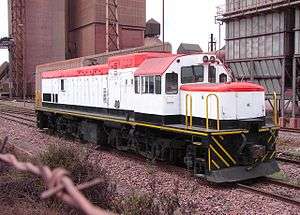South African Class 32-200
|
PPC Saldanha's no. 32-202, 8 January 2009 | |||||||||||||||||||||||||||||||||||||||||||||||||||||||||||||||||||||||||||||||
| |||||||||||||||||||||||||||||||||||||||||||||||||||||||||||||||||||||||||||||||
| |||||||||||||||||||||||||||||||||||||||||||||||||||||||||||||||||||||||||||||||
| |||||||||||||||||||||||||||||||||||||||||||||||||||||||||||||||||||||||||||||||
| |||||||||||||||||||||||||||||||||||||||||||||||||||||||||||||||||||||||||||||||
The South African Railways Class 32-200 of 1966 was a diesel-electric locomotive.
In June and July 1966, the South African Railways placed ten Class 32-200 General Electric type U20C1 diesel-electric locomotives with a 1Co+Co1 wheel arrangement in service in South West Africa, now Namibia.[1]
Manufacturer
The Class 32-200 type GE U20C1 diesel-electric locomotive was designed and built to South African Railways (SAR) requirements by General Electric (GE) and imported. The ten locomotives, a more powerful low short hood version of the earlier Class 32-000, were numbered in the range from 32-201 to 32-210.[1]
Class 32 series
The Class 32 consists of two series, the high short hood Class 32-000 and the low short hood Class 32-200, both GE products and both with a 1Co+Co1 wheel arrangement.[1]
Both locomotive series ran on the same 1Co' bogies, three-axle Co' bogies with additional integral single axle pony trucks, which was designed and produced by General Steel Castings. The fourth axle reduced the maximum axle loading sufficiently to enable these relatively heavy locomotives to operate on the very light rail which was used throughout South West Africa at the time.[2]
The Class 32-200 was, in reality, a Class 33-000 locomotive on the bogies of the Class 32-000, which reduced its maximum axle load from the 15,749 kilograms (34,721 pounds) of the Class 33-000 to 12,700 kilograms (27,999 pounds). Apart from the bogies, which necessitated a smaller fuel tank, its physical dimensions and exterior appearance were identical to that of the Class 33-000 and it used the same V12 prime mover.
Service
While it was acquired specifically for service on light rail in South West Africa, the Class 32-200s also ended up being employed in South Africa at times. From 1972 to 1974, between the withdrawal of the Class GO 4-8-2+2-8-4 Garratt locomotives and the arrival of the Class 35 diesel-electrics on the line between Amabele and Umtata in Transkei, some of them performed temporary service on that line.[3]
Of the original ten locomotives, most survived in service into the 21st century, some with TransNamib, the Namibian railway, or sold to Sudan Railways, or into industrial use to Gold Fields, PPC Lime in Saldanha and Sheltam.[4]
Works numbers
The Class 32-200 builder's works numbers and disposition are listed in the table.[4]
SAR no. |
GE works no. |
Post-SAR owner |
Post-SAR no. |
|---|---|---|---|
| 32-201 | 35842 | Sheltam | 2012 |
| 32-202 | 35843 | PPC | |
| 32-203 | 35844 | Sheltam | 2013 |
| 32-204 | 35845 | Goldfields | |
| 32-205 | 35846 | TransNamib | 205 |
| 32-206 | 35847 | TransNamib | 206 |
| 32-207 | 35848 | TransNamib | 207 |
| 32-208 | 35849 | TransNamib | 208 |
| 32-209 | 35850 | Sudan Ry | |
| 32-210 | 35851 | Sudan Ry | |
Illustration
The main picture and the following photograph offer views of two of the liveries in which they served.
 TransNamib's no. 205 at Windhoek station, Namibia, 26 June 2010
TransNamib's no. 205 at Windhoek station, Namibia, 26 June 2010
References
- 1 2 3 South African Railways Index and Diagrams Electric and Diesel Locomotives, 610mm and 1065mm Gauges, Ref LXD 14/1/100/20, 28 January 1975, as amended
- ↑ The American Locomotive Company - A Centennial Remembrance by Richard Steinbrenner
- ↑ Paxton, Leith; Bourne, David (1985). Locomotives of the South African Railways (1st ed.). Cape Town: Struik. pp. 138–139. ISBN 0869772112.
- 1 2 Middleton, John N. (2002). Railways of Southern Africa Locomotive Guide - 2002 (as amended by Combined Amendment List 4, January 2009) (2nd, Dec 2002 ed.). Herts, England: Beyer-Garratt Publications. pp. 38, 45, 47, 66.
| Wikimedia Commons has media related to South African Class 32-200. |
